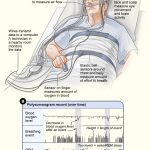SomnusNooze
Background
The primary feature of the two main central disorders of hypersomnolence—narcolepsy and idiopathic hypersomnia (IH)—is excessive daytime sleepiness, defined in the International Classification of Sleep Disorders, third edition, as “daily episodes of an irrepressible need to sleep or daytime lapses into sleep.” Overnight sleep testing (polysomnography) and a Multiple Sleep Latency Test (MSLT) are necessary to make the diagnosis of a central disorder of hypersomnolence. The differentiating feature between narcolepsy type 2 and IH is the number of sleep-onset REM (rapid eye movement) periods or SOREMPs. The diagnosis of narcolepsy type 2 requires the presence of two or more SOREMPs on the MSLT or one SOREMP on polysomnography and one on the MSLT. The diagnosis of IH can only be made if the person has one or no SOREMPs on polysomnography and MSLT combined. Because MSLT results often vary from day to day, several researchers have criticized the MSLT as being “insufficiently sensitive and specific to diagnose or rule out central hypersomnia.” Therefore, Bozluolcay et al sought to study the “utility of the number of SOREMPs in differentiating the central disorders of hypersomnolence.
Who were the researchers and what did they do?
Dr. Bozloulcay and his colleagues in Turkey examined the polysomnographic records of 101 patients with a central disorders of hypersomnolence, all of whom had a sleep-onset latency (time to fall asleep) on MSLT of 8 minutes or less. They divided the records into three groups: those with 2 or more SOREMPs (narcolepsy), 1 SOREMP (intermediate), or no SOREMPs (IH). They excluded records from any patients who had another sleep disorder or slept 10 hours or more per night.
What were the results of the study?
Of the 101 patients, 54 were diagnosed with narcolepsy, 26 were intermediate, and 23 were diagnosed with IH. Those in the IH and intermediate groups had a much longer time from symptom onset to diagnosis, as compared with the patients with narcolepsy (12.7 and 11.2 years vs 6.1 years). People in the narcolepsy and intermediate groups had shorter sleep latencies and REM latencies on both polysomnography and MSLT, as compared with people with IH. Of the people with narcolepsy, 56.6% woke directly from REM sleep, as did 50% of the patients in the intermediate group, and 34.2% of patients in the IH group. Twenty people with narcolepsy had a SOREMP on overnight polysomnography; none of those in the other two groups had this finding. Half of the people with narcolepsy had cataplexy, as did one in the intermediate group. None of the people with IH had cataplexy.
What were the researchers conclusions?
In the complex and frequently misleading characterization of idiopathic hypersomnia, conventional MSLT data should be carefully considered together with newer approaches.
Our results demonstrated that the presence of one SOREMP in MSLT or PSG should carefully be questioned in the context of clinical symptomatology, and alternative diagnostic strategies are needed to more accurately and reliably characterize the non–hypocretin-deficient hypersomnias.
Source
Bozluolcay M, Nalbantoglu M, Benbir Senel G, Karadeniz D. What does one sleep-onset REM period—during either nocturnal polysomnography or Multiple Sleep Latency Test—mean in differential diagnosis of central hypersomnias? J Clin Neurophysiol. 2015;32(4):364-368.
This article was written by a volunteer medical writer and reviewed by Dr. Chad Ruoff. Note that this study did not include patients with IH who slept for 10 or more hours per night.

